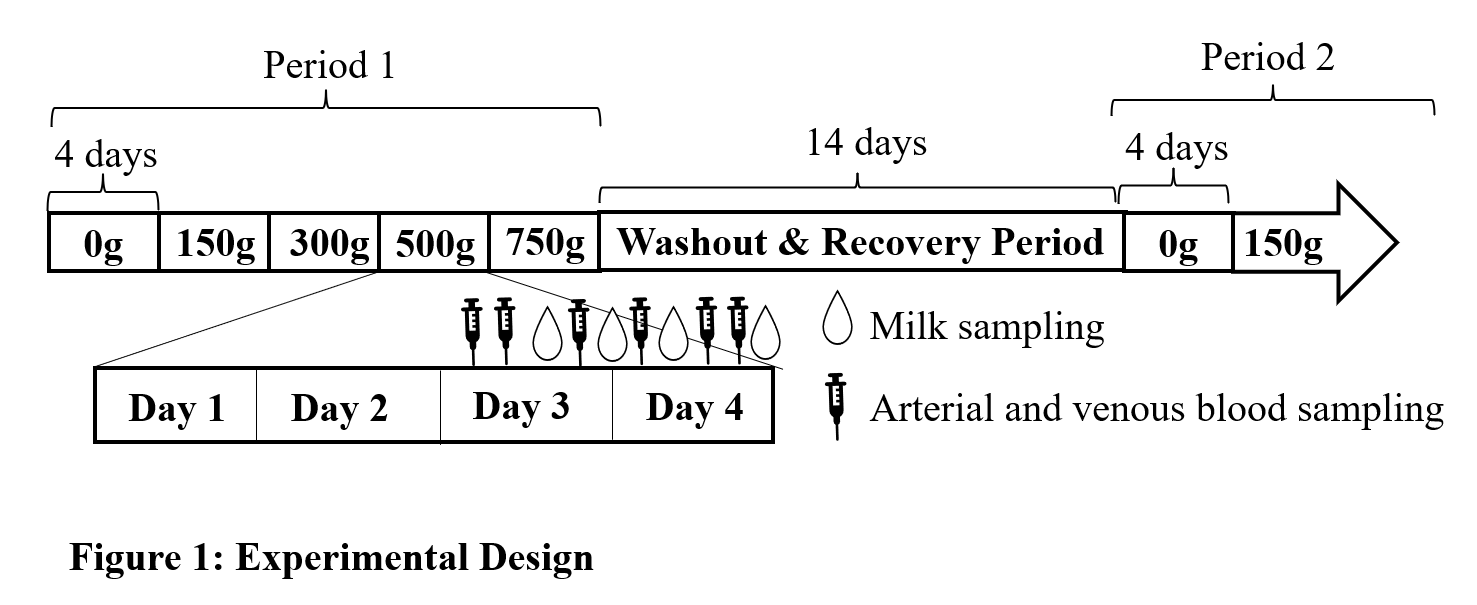Progress report for GNE22-302
Project Information
Fatty acid (FA) supplements are commonly fed to lactating dairy cows to increase energy intake and milk fat yield, but these supplements also shift milk FA profile and ultimately influence the physical characteristics of milk fat. Consumers have recently voiced interest in butter melting properties as highlighted by the large controversy over the effect of FA supplements on butter hardness. This started with a Canadian tweet that subsequently went viral, making international news as “Buttergate”. The objective of this proposal is to characterize how increasing dietary palmitic acid affects milk fat melting temperature compared to stearic acid or a no-supplement control. The hypothesis is that palmitic acid will increase milk fat melting temperature compared to stearic acid or control, with greater differences observed at higher doses. We will analyze the melting properties of milk fat using differential scanning calorimetry from milk samples collected during the applicant’s (Alanna Staffin’s) USDA sponsored trial studying the influence of palmitic and stearic acid dose on mammary metabolism and milk FA profile. This SARE proposal will provide timely characterization of the impact of FA type and dose on milk fat physical characteristics. The results will be communicated through a variety of extension platforms such as the Penn State Dairy Nutrition workshop and online resources as well as in academic settings through peer-reviewed journals and conferences. Ultimately, this proposal will allow northeastern dairy producers, nutritionists, and processors to make more informed decisions regarding dietary interventions that influence butter quality to stay competitive or create niche products.
- Characterize how increasing palmitic acid supplementation affects melting properties of milk fat compared to stearic acid supplementation or a no-supplement control
The purpose of this project is to characterize how increasing palmitic acid supplementation in lactating dairy cows affects milk fat melting temperature compared to increasing stearic acid or a no-supplement control.
United States (US) dairy farmers are paid for total milk fat and protein shipped and therefore aim to increase production of these components. Milk fat is the major energy component of milk and is also the most responsive to nutritional and environmental regulation (Harvatine et al. 2009). Changes in scientific and public perception regarding dietary fat has supported higher prices for milk fat over the past decade and a subsequent interest in supplementing dairy rations with fatty acids (FA), such as palmitic and stearic acid, to improve energy intake and milk fat yield, as these FA are common in feedstuffs and are a large portion of the FA found in milk (~28%, and 11% respectively, Jensen 2002). Over the past decade, palmitic acid supplementation has become increasingly popular as it more consistently increases milk fat yield compared to other FA supplements (Loften et al. 2014). While FA supplements can increase production, it is important to understand how these supplements influence the type of FA available to the mammary gland and ultimately the FA profile and physical properties of milk fat. There are still significant gaps in our knowledge of how each FA, which has its own unique chemical and physical properties, influences mammary metabolism, milk synthesis, and ultimately milk’s physical and organoleptic characteristics.
One physical characteristic pertinent to processors and consumers is the melting properties of milk fat, which influences butter hardness and quality. Recently, consumers have voiced concerns that butter is not as soft at room temperature as it used to be. These concerns started as a Twitter post in Canada asking if anyone had noticed butter was harder at room temperature. This post went viral, quickly gaining momentum in Canadian and international news as journalists named the situation “Buttergate” and increasing palmitic acid supplementation became the suspected cause (Harvatine 2021). The public concern was significant enough to cause Canadian processors to request producers to reduce or eliminate palmitic acid supplementation until the issue could be resolved.
Although there is evidence from a limited number of studies that palmitic acid supplementation increases milk fat melting temperature (Enjalbert et al. 2000, Chamberlain and DePeters 2017), some dairy nutritionists and industry professionals were quick to dismiss the idea that palmitic acid supplementation could have a big enough effect for consumers to perceive a difference in butter hardness (Harvatine 2021). Consumer interest in the melting properties of butter provides the opportunity for the dairy industry to develop niche and value-added products. Instead of disregarding consumer concerns, we need further investigation into the effect of FA supplements on milk fat properties to efficiently meet these demands and remain economically viable. The goal of this research is to determine the optimal FA supplementation strategy that would balance the profitability of increasing overall milk fat production while still delivering a desirable product for consumers.
Cooperators
- (Researcher)
Research
Objective 1:
Experimental Design: The proposed research will involve processing and analyzing milk samples collected during an ongoing project conducted by my (Alanna Staffin’s) USDA predoctoral fellowship. The experiment will consist of twelve, post-peak (>80 days in milk) multiparous Holstein cows in a replicated 3x3 Latin square design. Treatments will include a no-supplement control (CON), palmitic acid supplementation (PA), and stearic acid supplementation (SA). PA and SA will be fed in free FA prill form with 5% oleic acid to aid in digestion (Shepardson and Harvatine 2021). PA and SA will be mixed into the total mixed ration in a dose-escalation model within each period to target 0g, 150g, 300g, 500g, and 750g per day intakes (Figure 1). Each dose will be fed for 4 days. Maximal transfer of absorbed FA to milk is expected to occur within 12 hours, allowing the use of short periods (Harvatine and Bauman 2011). Additionally, these saturated FA are considered inert in the rumen, so no rumen adaptation period is needed. Arterial and venous blood sampling and milk sampling (PM and AM) will occur across the third and fourth days (Figure 1). At the end of each full period (after 750g dose), there will be a 14-day washout and recovery period where cows are fed the CON diet before starting the next treatment period.
USDA Sponsored Analysis: Briefly, the concentration and FA profile of plasma triglyceride and free FA fractions will be determined as these are the fractions available to the mammary gland. This will allow for the determination of mammary uptake efficiency of palmitic and stearic acids at various doses of supplementation. Milk fat concentration will be determined through Fourier Transform Infrared Spectroscopy (FTIR) and milk FA profile will be determined through gas chromatography (Baldin et al. 2018).
Proposed SARE Analysis: Under this proposal, additional milk samples will be collected at the same milk sampling during the trial to determine how the supplemented type and dose of FA affects milk fat melting properties including temperature. Milk samples from days 3 and 4 of treatment at each dose will be composited according to milk yield into one sample per cow for each combination of FA treatment and dose. Milk lipids will be extracted using hexane:isopropanol and dried under nitrogen. Anhydrous milk fat samples will then be analyzed using a Q600 SDT (TA instruments, New Castle, DE) to conduct differential scanning calorimetry (DSC). Briefly, an empty alumina pan will be used as a reference and calibrated with indium as described by Shepardson et al. (2020). A ~5 mg portion of extracted milk fat will be weighed and placed in an alumina pan inside the instrument. The sample will first be melted and then solidified under a controlled cooling program to standardize crystallization as described by Tomaszewska-Gras (2013). The sample will be heated to 50°C for 5 minutes to melt all crystals before a controlled cooling from 50°C to -40°C at a rate of 5°C/min. Samples will then be held at -40°C for 5 minutes. Following cooling, samples will be heated at a rate of 5°C/min from -40°C to 60°C and melting curves recorded for analysis (Tomaszewska-Gras 2013). The TA universal analysis software will be used to determine the primary response variable, melting temperature, for each sample. A secondary analysis of enthalpy, or the amount of energy required to melt the sample, will be conducted to give an indication of the crystallization structure of milk fat. Melting temperature will be designated at the nadir of the melting curve and enthalpy will be determined through integration of the curve (Shepardson et al. 2020). Previous work in our lab with differential scanning calorimetry has shown low variation (<1.5% for melting temperature and <3.6% for enthalpy) between samples using quadruplicate runs on FA stocks (Shepardson et al. 2020), which allows us to run our samples in single.
Statistical Analysis: Data will be analyzed for the linear effect of increasing PA and SA on milk fat melting temperature. Preplanned contrasts will also compare milk fat melting temperature of PA and SA treatments at each level. Finally, a regression analysis will be performed to determine relationships between the milk FA profile data collected with USDA sponsored funding and milk fat melting temperature determined by this proposal.
Expected Results and Outcomes: The main response variable for this proposed research is milk fat melting temperature. Our hypothesis is that palmitic acid will increase milk fat melting temperature compared to stearic acid or control, with a greater difference observed at higher doses. We also expect that palmitic acid supplementation will increase the concentration of palmitic acid in milk fat in a dose dependent manner, while stearic acid supplementation will increase the concentration of both stearic and oleic acid in milk fat due to an enzyme called stearoyl-CoA desaturase, which converts a large proportion of saturated stearic acid into unsaturated oleic acid within the mammary gland (Bernard et al. 2013). This shift in FA profile is expected to cause differences in milk fat melting temperature between palmitic and stearic treatments. Overall, this research will provide timely insight as to how the type and dose of FA supplemented not only influences mammary metabolism and milk FA profile (USDA funding), but the physical characteristics of milk fat as well (SARE proposal).
Palmitic acid supplementation dose-dependently increased palmitic acid in milk fat, while stearic acid supplementation dose-dependently increased both stearic and oleic acid in milk fat.
Solid fat content (SFC) at 3 and 20°C are relevant to products stored at refrigerator and room temperature. For 20°C, PA dose-dependently increased SFC compared to CON starting at 300 g/d, up to 5.3 percentage units greater at the 750 g/d dose. At 3°C, PA increased SFC at 750 g/d by 1.4 percentage units. At 3 and 20°C, SA decreased SFC compared to CON starting at 500 g/d. This resulted in a decrease in SFC at the 750 g/d dose of 2.3 and 3.2 percentage units for 3 and 20°C, respectively. Peak and end melting temperatures of butter oil were also dose-dependently increased by PA.
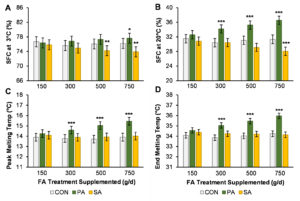
Solid fat content was tested from 0 to 40°C with data analyzed within dose with a model testing the effect of treatment, temperature, and their interaction. At the 150 and 300 g/d dose, there was an effect of treatment and temperature (both P < 0.001) but no interaction. The SFC of PA was consistently higher than CON at both doses (P = 0.02). The average SFC of SA was lower than CON at the 150 g/d dose (P = 0.03) but did not differ at the 300 g/d dose (P = 0.97).
At the 500 and 750 g/d doses, there was an interaction between treatment and temperature (P < 0.001), where PA increased SFC of butter oil compared to CON from 15 to 40°C (P < 0.001 for all) but not at lower temperatures. At the 500 g/d dose, SFC was lower (P < 0.05) in SA compared to CON at most temperatures 20°C and below, while at the 750 g/d dose, this expanded to include most temperatures between 0°C and 40°C.
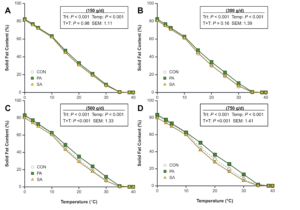
Simple linear regression revealed a positive linear relationship (R2 = 0.57) between palmitic acid percentage of milk fat and SFC of butter oil at 20°C.
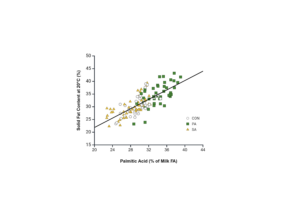
Simple linear regression also revealed a negative relationship between oleic acid percentage of milk fat and SFC of butter oil at 20°C.
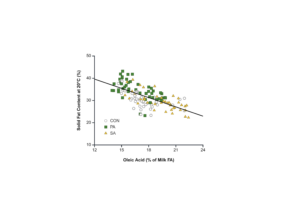
The butter spreadability index, which is the ratio of palmitic to oleic acid in milk fat, is used as an indicator for butter hardness, with a higher number predicting less spreadable butter. The butter spreadability index had linear relationship (R2 = 0.61) with SFC of butter oil with our samples, supporting its use as a simple predictor of milk fat melting properties.
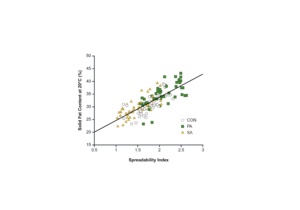
Education & Outreach Activities and Participation Summary
Participation Summary:
Penn State Extension hosts an annual, 2-day dairy nutrition workshop designed to communicate applied dairy nutrition research and provide training to about 600 industry professionals including producers, nutritionists, veterinarians, and extension educators. The advisor for this proposal, Dr. Kevin Harvatine, is responsible for organizing this workshop and has significant input regarding conference topics. This research, along with other related research from our laboratory focusing on nutritional factors that impact melting properties of milk fat, will be presented at this workshop to allow for an interactive space for discussion of the topic with a variety of stakeholders. Penn State Extension also has a strong online presence with significant resources available to industry professionals. The Penn State Dairy Digest newsletter is published online six times per year covering a variety of farm management topics. We plan to share the results of this research in a Dairy Digest article to discuss how increasing palmitic and stearic acid supplementation can influence milk fat characteristics and its subsequent impact on milk processing. Videos and webinars are also available through online extension platforms and are frequently viewed. We plan to create an online video targeted towards producers and nutritionists discussing how the type and dose of fatty acid supplemented in dairy rations affects milk fat melting temperature.
The results of this research will also be presented at the American Dairy Science Association (ADSA) Annual Meeting to facilitate and encourage discussion from other researchers, who’s work spans from dairy production to dairy foods, on the issue. This is especially important considering the lack of attention given to this issue by the research community despite significant public concern. Finally, this research will be published in ADSA’s Journal of Dairy Science, which is the primary journal in the United States for dairy production and dairy foods research and has significant international impact.
Once research has been further developed in this area, there is potential to host workshops for artisan dairy producers on how to tailor dietary strategies towards feeding for specific milk product characteristics. Additionally, there is potential to facilitate roundtable discussions between local producers and processors to encourage communication across the supply chain to meet consumer demands and increase market competitiveness against imported butter products.
Project update:
The results of this experiment was presented to a group of farmers, dairy nutritionists, researchers, extension educators, and other industry professionals at the Penn State Nutrition Workshop in November 2023 in Hershey, PA. My advisor (Dr. Kevin Harvatine) also gave a webinar presentation with the data from this project. I also presented this data to a wide variety of audiences including Penn State life science and agriculture students, producers and other industry personnel at the Penn State Board of Trustees meeting, and at the American Dairy Science Association annual meeting. We plan on also writing an extension article with this data to reach even more farmers and industry personnel besides the ones that attended our workshop.
Project Outcomes
The audience was very engaged and asked a number of questions at the dairy nutrition workshop where this research was presented. There was also more discussion that followed throughout the rest of the workshop. Additionally, I had multiple one on one conversations with Pennsylvania dairy producers at the Penn State Board of Trustees meeting who were unaware that fat supplementation could affect milk fat properties. They were interested in asking questions and finding out more information, but also stated that there would need to be financial incentives in place for farmers to adopt feeding techniques that would shift milk fat to desirable melting properties.
While we were expecting to see increased percent solid of our butter oil at room temperature with palmitic acid supplementation, the magnitude at which it did so was a little surprising. When consumers first voiced concerns about their butter being hard and blamed palmitic acid, many dairy industry professionals were quick to dismiss the idea. While we would need further research with a consumer panel to ensure the differences we observed could be noticed by consumers, it helped us confirm that to remain sustainable as a dairy industry, producers and processors need to understand how cattle nutrition influences the properties and quality of their products. I would like to follow up with this research, both through running consumer panels of butter from cows supplemented with different fatty acids, and through facilitating discussions between producers and processors to see if there is potential for financial incentives for farmers to feed their cattle in a way that can provide specialty processors with milk fat containing specific melting properties.
